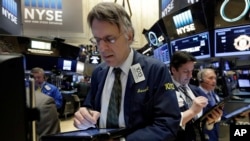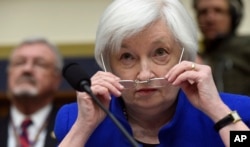The S&P 500 continued one of its biggest comebacks in history Friday, closing up for the year for the first time after rallying 200-plus points since the February 11 low. Meanwhile, the Dow Jones industrial average has traded higher 12 out of the past 14 trading sessions.
The surge in stocks since the low has been due to the rally in crude oil. It recently crossed over $40 a barrel, a level it has not seen in months. As crude oil moved higher, so did the S&P 500 energy-related stocks like Exxon Mobil and Chevron.
The financial sector also made a comeback. Since the energy and financial sectors make up more than 22 percent of the index, they pulled the index down in January and the first few days of February. Now that both sectors have enjoyed a recovery, the S&P 500 has moved along with them.
The biggest driver of the upward momentum this week was the Federal Reserve as it announced that there would be no interest rate hikes, and it scaled back forecasts to two quarter-point raises in 2016.
View changed
In December, Fed Chairman Janet Yellen said the Fed was on a course for gradual increases in short-term rates at a pace of four for the year. That outlook changed with falling commodity and stock prices, instability in China’s policy and slowing global growth.
It is interesting to see the financials shrug off the Fed’s policy move because banks benefit from higher interest rates, since they boost their net margins. Lower interest rates make it more difficult to grow those margins, and that is the environment we are in right now.
Ultra-loose monetary policy has added fuel to the bullish fire in the stock market, but is this type of move to the upside good in the long-term?
“Markets now heavily rely on central bank intervention, and the move higher in the S&P 500 is not based on corporate earnings or global market growth,” Steve Kalayjian of the Kalayjian Report said. “The Federal Reserve and global central bankers are trying everything from quantitative easing to negative interest rates, but that only artificially inflates assets and does not generate any actual growth.”
With the market surging over recent weeks, investors are wondering whether it's too late to join the near-term party or whether a pullback is due.
Bob Lang, founder of Explosive Options, said, “I am a trend trader, and it is important for investors to never try to pick the tops and bottoms in markets. With this enormous stock market run, I would selectively add new, small positions, and certainly take profits along the way. I am expecting some pullback in the market and I don’t want to lose good profits along the way.”
Trading week ahead
As a reminder, U.S. markets will be closed on Good Friday, March 25, although banks remain open. While it is a holiday-shortened week, traders still have a lot of data and market-moving events to contend with.
Even though the Federal Reserve announced it will not raise interest rates and it decreased its rate hike expectations in 2016 to two from four, traders will still have to jockey around monetary policy headlines as several Fed presidents are slated to speak on the U.S. economy this week, including Jeffrey Lacker, Dennis Lockhart, Charles Evans, Patrick Harker and James Bullard.
Speakers tend to move the markets as their comments hit newswires because they could give clues into what the Fed may be doing with future monetary policy and the general state of the economy.
Key economic data for the week include new and existing home sales, durable goods, and crude oil and natural gas inventory reports. And, while all of these reports are important in their own right, they all lead up to the final gross domestic product data. Markets will be closed Friday, but the data will still be released.
GDP is the all-inclusive measure of economic activity. There are four major categories: personal consumption expenditures, investment, net exports and government. It helps the Federal Reserve and investors gauge the strength or weakness in consumer spending, business and residential investment, and inflation. Unemployment data and GDP are major factors the Fed considers when creating monetary policy.
Company results
The economic calendar remains quiet until mid-April, when the second-quarter reporting season gets underway. That said, there are a handful of companies delivering results that investors should be aware of: General Mills, K.B. Homes and Nike.
Nike has been an outperformer in the past month, having gained 5.86 percent, outpacing the S&P 500 by nearly 0.5 percent. The company has capitalized on the “athleisure category,” a global lifestyle trend, and it also announced its first self-lacing shoe on Friday.
Rob Campagnino, consumer strategist for SSR, reviewed expectations for Nike’s earnings results, to be released Tuesday after the stock market closes:
“As we saw solid international sales results from names such as Under Armour, Adidas and Puma, we think the global athletic footwear cycle remains robust, and Nike is very well-positioned. One source of concern may be North America, where retail results in the calendar fourth quarter were mediocre at best. Elevated inventory may translate into some calendar first-quarter gross margin pressure for Nike, but we see the issue as temporary.”
Apple is not reporting earnings in the week ahead, but it is holding its product event launch Monday. This is what the techies, traders and the media will be looking for: a new, low-end iPhone model, a 9.7-inch iPad, new Apple Watch band and a plethora of software updates.
The stock will jump around as the event unfolds, but will it change the long-term outlook on the stock?
Andy Hargreaves, consumer, Internet and digital media analyst at Pacific Crest Securities, said in a research note, “We do not expect the new hardware or software to materially alter our outlook for earnings or our view of the stock.”








